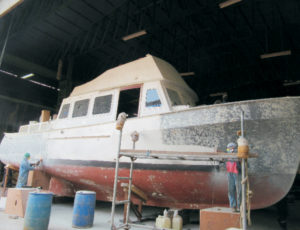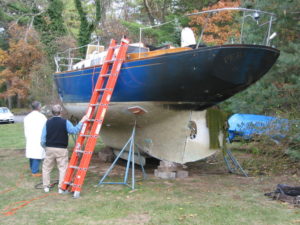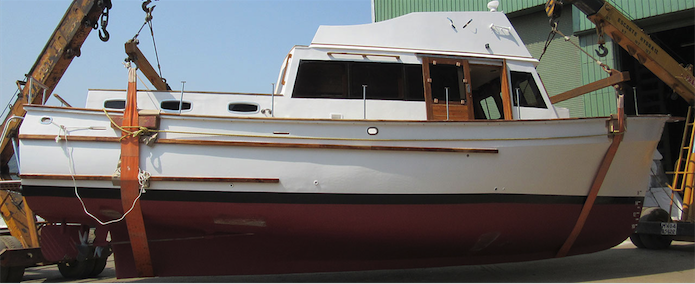It isn’t every day that you get up and buy a boat, so once you do, it is important that you take good care of it to keep it ship-shape and running efficiently. Most boat owners are aware that they need to take care of their boats, but the ‘how’ is a big question.
Which is why, we decided to talk to our boat maintenance and repair experts, here at SHM, to give you some interesting insights on how to take excellent care of your most prized possession and keep it functioning at peak efficiency.
In this article, we cover all you need to know – from the steps of boat repair and common problems why boats are damaged, to the materials used and on repairing the electrical, mechanical, and core components of the boats.
Read on!
Interacting with Experts on Boat Repairs and Maintenance
#1 Steps of Boat Repairs
The very first question that comes to mind when we think of boat repairs and maintenance is, what exactly are the steps in boat repairs. How does one decide when to start with boat maintenance? Well, the answer is two-pronged. There are two types of boat repairs – preventive maintenance repairs and breakdown repairs.
As the names suggest, preventive maintenance repairs are done periodically to ensure that the boat is in proper working condition, all parts are well-maintained and functional, even when there is no apparent damage. Ensuring preventive boat maintenance repairs helps in avoiding breakdown maintenance, where the boat is repaired after one of its parts breaks down.
#2 Assessing the Level of Damage to the Boat

Having cleared that preventive boat maintenance is the solution, the next question is, how do we assess the level of damage so that the necessary preventive repairs can be initiated. Here, expertise in boat repairs comes into the picture, as one has to be able to predict where exactly the boat may fail if not shored up properly. Of course, running it through stress analysis and strength measurement tests also helps, but, nevertheless, years of experience and an understanding of where the boat may fail goes a long way in helping with the boat repairs.
One of the best ways of assessing the level of damage is through actual physical inspection of the boat. Another way is to check the previous maintenance schedules and operating procedures of the boat manager. Comparing those reports and the present condition of the equipment gives a fair idea of the level of damage in the boat and which parts need to be worked upon.
#3 Common Reasons why Boats Need Repairs
The obvious follow-up question is, how to identify when a boat is in need of repair? If the signs of damage are evident only after a physical inspection, how can one predict when is a servicing due? Well, here is the most common reason why a boat might need repairs.
The main problem is the negligence of boat operators. If a boat operator handles the equipment carefully, as mentioned in the manual, and ensures that the equipment is cleaned from time to time, the need for full-fledged breakdown boat repairs will never arise.
#4 Materials used for Boat Repair

Even so, considering that there is some large-scale damage to the boat, how can it be repaired? What are the materials required and what is the procedure? To know which materials are used, one must first know what the damage is; is the boat delaminated or there is hull damage, or has the core been damaged.
For instance, the epoxy resin may be used for repairing damage to the hull of a fibreglass boat. Initially, this used to be a polyester resin, however, with changing hull design, the repair materials have changed as well. While the polyester resin is still used in manufacturing fibreglass boats, epoxy is an excellent adhesive as a laminating resin and coating solution on account of its thin-film cure characteristics and resistance to micro-cracking.
The production team assists and performs boat repairs, referring to the said manuals for identifying and using the best materials for the purpose of boat repairs.
#5 Hull repair

Elaborating on this topic, we discuss how a damaged hull can be repaired. There are two scenarios where a boat hull can be damaged – one is when the hull is damaged above the waterline, the second when it is damaged below the waterline.
In the first scenario, the boat can be repaired while in the water itself. However, if the boat is damaged below the waterline, and there is continuous ingression of water, it should be promptly taken out into the dry and inspected thoroughly. For hull repair, a basic fibreglass repair kit is used, using which the damaged section is removed in a circular cut. The part can be then patched using either fibreglass and the proper adhesives or the putties available.
#6 Core repair

A damaged core is one of the worst things that can happen to a boat. Which is why, repairing a damaged core is a long, tedious, and expensive task.
Core damage primarily happens due to the intrusion of water through hull-fittings or deck-fittings. As foam, lightweight woods like end-grain balsa or plywood, or even aluminium honeycomb are chiefly the materials used for making cores, any exposure to water slowly eats away at it and the core starts rotting.
Repairing the damage to the core involves removing the fibreglass skin to expose the core, which is as good as making it anew. The basic solution to repairing the core is to open the affected area, remove any water and delaminated core, and insert a replacement core that re-establishes the structural integrity of the boat.
#7 Electrical maintenance and repair

Apart from the structural components of the boat, the electrical components need to be maintained equally well. Electrical maintenance primarily involves periodic checks of the complete electrical equipment to ensure that it is functioning as per specifications.
In addition, cables and wire fittings are checked to ensure that they are not loose. Blown fuses are replaced with those of the same capacity, not greater. All motors and blowers are checked for bearing clearances, insulation, and energy consumption to determine whether they are functioning at optimum efficiency.
#8 Repair Procedures for Different Types of Boats
Having seen all these repair procedures, one might wonder, since the basic components of a boat are the same, how exactly do the repair procedures differ? Or are they the same for all types of boats? Well, that isn’t so. Boat maintenance and repair procedures differ for different types of boats, depending on the design, capacity, and structure of the boat.
Although the hull is essentially fibreglass, there are a lot of differences at the engineering end when it comes to repairs. Depending on whether the boat has a drive shaft, or a waterjet, or whether it is directly coupled, or a sterndrive, or it is directly propelled, and so on, the repair and maintenance procedure is decided.
#9 Checklist post boat repairs
Once all boat repairs are done comes the question of ensuring whether they are all really done. To this end, there can be a checklist of sorts to check whether the boat is fully functional post repairs. This includes:
- Boat trial reports pre- and post-repair
- Equipment trial reports pre- and post-repairs
- Comparison of boat performance to expected performance as per the OEM manuals
- Final checks to ensure the boat is seaworthy
#10 Tips for Boat Maintenance
As we have seen throughout the article, there is a need for continuous boat maintenance to avoid breakdown repairs and keep the boat functioning at maximum efficiency. Even the most inexperienced of seafarers can follow these tips for boat maintenance so that they take proper care of the boat and ensure its longevity:
- Go through the manuals, equipment, and pipelines whenever you are on any new vessel.
- Opt for regular preventive maintenance of the boat to avoid breakdown maintenance
- Keep an eye out for small deviations from the performance or any possible malfunctions and immediately get the boat inspected if any are found.
Endnote
To sum up, it wouldn’t be wrong to say that prevention really is better than cure!
Preventive boat maintenance can go a long way in maintaining boat efficiency and increasing the lifespan of the boat. Given the fact that breakdown boat repairs can cost a heavy buck and take a lot of turnaround time, it is wise to keep a handle on things well in advance.
There are several boat manufacturers and repair service providers in India, like SHM Shipcare, who can offer valuable guidance and assistance when it comes to professional and skilled boat repairs.
What are your thoughts about boat repairs? Any suggestions you would like to add? Drop a comment to let us know!




My aunt is thinking about buying a yacht. If it ever got damaged it could be really nice for her to be some repair from a professional. It was interesting to learn about how she should assess the level of damage to the boat.